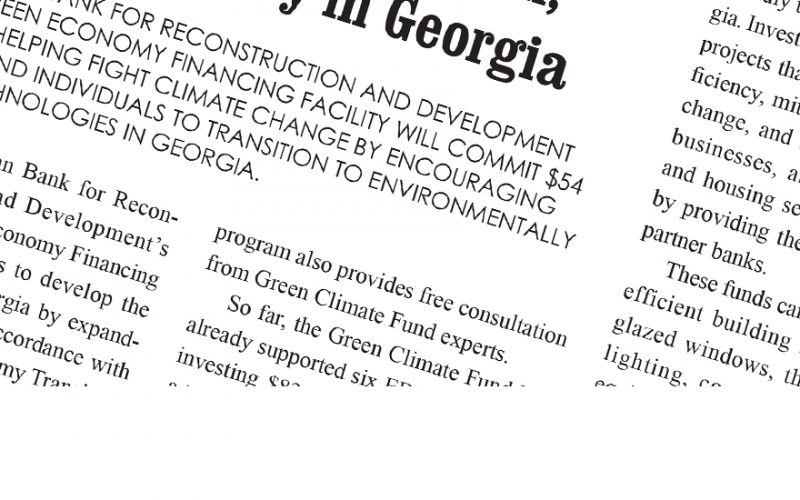EBRD green financing pushing climate change mitigation, energy efficiency in Georgia
The European Bank for Reconstruction and Development (EBRD)’s Green Economy Financing Facility will commit $54 million to helping fight climate change by encouraging businesses and individuals to transition to environmentally friendly technologies in Georgia.
The European Bank for Reconstruction and Development’s new Green Economy Financing Facility (GEFF) seeks to develop the green economy in Georgia by expanding green financing in accordance with the EBRD’s Green Economy Transition approach.
In addition to direct financing, the program also provides free consultation from Green Climate Fund experts.
So far, the Green Climate Fund has already supported six EBRD programs, investing $830 million and mobilizing a total of $3.6 billion across the globe.
The total budget of the GEFF program in Georgia is $54 million.
Through this program, companies will gain access to environmentally friendly technologies available in Georgia. Investments will be directed towards projects that aim to improve energy efficiency, mitigate the effects of climate change, and help small and mid-sized businesses, as well as the corporate and housing sectors, adapt to changes by providing them loans through local partner banks.
These funds can be spent on energy-efficient building materials, double-glazed windows, thermal insulation, lighting, construction, agricultural equipment and machinery, photovoltaic solar panels, geothermal heat pumps and water-saving irrigation systems.
What green financing has done for Georgia already
The GEFF follows on the heels of the EBRD’s Energocredit project, which was funded by the European Union (EU) and the Austrian Federal Ministry of Finance.
Energocredit was carried out as part of the Caucasus Energy Efficiency Program, which included the three countries of the South Caucasus: Georgia, Azerbaijan and Armenia.
In Georgia, this project was launched in 2012 and lasted until 2018. The country was given a $45 million credit line to launch several green initiatives. Thanks to the project, 31 companies and more than 29,000 households received over 42 million euros to fund energy-efficient projects from six local banks – TBC Bank, Bank of Georgia, Respublika (now TVS Bank), Basisbank, VTB-Georgia and Credo.
Recently summing up the results of the Energocredit project, the EBRD recognized six of the best projects in the field of energy efficiency and renewable energy for their contribution in promoting the tenets of green economy in Georgia. Energocredit partner banks were also commended for their continued support of green energy projects.
The prize winners were Liderfood, Museum Hotel, Georgian Building Group, Archi Tower, Shilda hydropower plant and Innovo Medical Center.
Each of these companies has a long and fruitful history in the field of energy efficiency.
The Museum Hotel is located in a historical building in the center of Tbilisi. During its reconstruction, the hotel administration used an EBRD credit line to introduce energy-efficient technologies.
The GCF consulting team conducted a detailed analysis of the project, studied potential energy savings, determined the financial and technical parameters, and made recommendations. The investment amounted to $237,000 USD and the hotel was able to decrease its energy consumption by almost 90%, as the new energy-efficient technologies allow them to save 242,975 MWh of natural gas, and 4,206 MWh of electricity per year.
Another example of just how big a difference implementing greener technologies can make comes from one of the leading cement plants in Georgia, the Georgian Building Group. Their equipment was rather outdated, and most of their production costs came from electricity.
To strengthen its position on the market, the company decided to modernize the production process and replace obsolete equipment.
With the help of an Energocredit line, the company not only received a $1.5 million loan, but also recommendations from a group of design engineers on how to best equip the enterprise, reducing energy costs by 40%. The company’s C02 emissions have also been greatly reduced.
How the Green Economy Financing Facility differs from Energocredit
The Green Economy Development Program was launched on December 10, 2019 in Georgia, building off of the old Energocredit structure, undergoing a rebranding process and adding new selection criteria.
While Energocredit aimed to improve energy efficiency, the focus of the GEFF will be the efficient use of resources, whether in transport, agriculture, hospitality or other sectors.
The credit line must be utilized within two years.
Many banks will join this project, the first of which is ProCredit Bank, which has signed an agreement with the European Bank for Reconstruction and Development to receive 25 million euros.
This amount will be divided into two tranches. The first will amount to 15 million euros, and is intended for entrepreneurs and individuals who seek to invest in modern technologies designed to reduce costs, improve quality of life and protect the environment.
Next in line are the Georgian Leasing Company and Basis Bank; TBC Bank and Bank of Georgia will join later in 2020.
A credit line is available to all interested financial institutions.
Legislation remains a key element of success
But these projects alone are not enough: legislation must also be changed to reflect innovations in the field of green technologies, says Director of the Georgia Energy Efficiency Center Giorgi Abulashvili:
“The legislative framework in the field of energy efficiency in Georgia is only now being formed, working off the association agreement with the EU, as well as four European directives. Accordingly, four laws should be adopted on which the development of energy efficiency will be based.”
The first in a set of new green bills establishes requirements for the energy-efficiency of buildings. The second relates to energy efficiency across all sectors, including energy-efficient construction and building requirements. The third is a bill introducing energy efficiency labeling, and a directive on environmentally friendly design will also be introduced.
These three bills and the directive have already been introduced in parliament.
“But adopting new laws is only the beginning. In addition, a number of by-laws should also be drafted, according to which incentives will be created, state programs prepared, and standards determined”, Abulashvili says.

